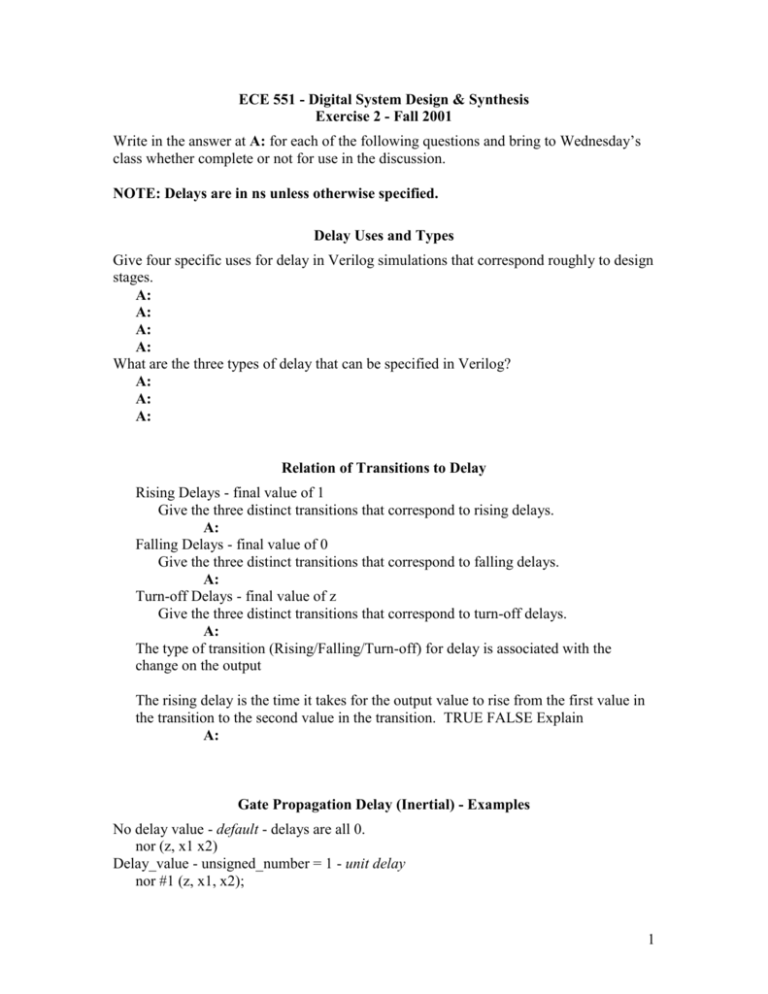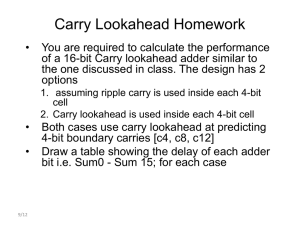ECE 551 - Digital System Design & Synthesis Exercise 2
advertisement

ECE 551 - Digital System Design & Synthesis
Exercise 2 - Fall 2001
Write in the answer at A: for each of the following questions and bring to Wednesday’s
class whether complete or not for use in the discussion.
NOTE: Delays are in ns unless otherwise specified.
Delay Uses and Types
Give four specific uses for delay in Verilog simulations that correspond roughly to design
stages.
A:
A:
A:
A:
What are the three types of delay that can be specified in Verilog?
A:
A:
A:
Relation of Transitions to Delay
Rising Delays - final value of 1
Give the three distinct transitions that correspond to rising delays.
A:
Falling Delays - final value of 0
Give the three distinct transitions that correspond to falling delays.
A:
Turn-off Delays - final value of z
Give the three distinct transitions that correspond to turn-off delays.
A:
The type of transition (Rising/Falling/Turn-off) for delay is associated with the
change on the output
The rising delay is the time it takes for the output value to rise from the first value in
the transition to the second value in the transition. TRUE FALSE Explain
A:
Gate Propagation Delay (Inertial) - Examples
No delay value - default - delays are all 0.
nor (z, x1 x2)
Delay_value - unsigned_number = 1 - unit delay
nor #1 (z, x1, x2);
1
Delay_value - unsigned_number 1 - prop delay
nor #5 (z, x1, x2);
Delay_value - parameter_identifier - allows easy change of delay value
nor #nor_delay (z, x1,x2);
What is the delay from input A to output Y in the following circuit assign unit time of
1ns.
NOR #3 X1 (D, A, B, C),
#4 X2 (Y, D, E, F);
A:
ns
Gate Propagation Delay (Inertial) - Examples
Delay_value2 - unsigned_number - rising delay, falling delay
Describe the delays for: nor #(1,2) (z, x1, x2).
A:
Delay_value3 - unsigned_number - rising delay, falling delay, turnoff delay
Describe the delays for nor #(3,2,4) (z, x1, x2).
A:
Delay_value3 - constant_mintypmax_expression - rising delay - min:typ:max, falling
delay - min:typ:max, turnoff delay - min:typ:max
Describe the delays for nor #(2:3:4, 1:2:5, 2:4:6).
A:
Gate Propagation Delay (Inertial) - More
Constant_expression is quite complex - see Formal Syntax in text
Describe the delays for nor #(3.2:3.5:4.0, 4.1:4.5:5.2, 5.1:5.5:6.2).
A:
Describe the delays for nor #(nor_r_m : nor_r_t : nor_r_x, nor_f_m : nor_f_t :
nor_f_x, nor_t_m : nor_t_t : nor_t_x).
Describe the delays for nor #(del_switch ? nor_d_1 : nor_d_2).
A:
See Table 6.1, p. 135 of text.
What are delays for x and z values within transitions?
A:
Simulation Time Scales
Compiler Directive `timescale <time_unit> / <time_precision>
2
time_unit - the time multiplier for time values
time_precision - minimum step size during simulation - determines rounding of
numerical values
Allowed unit/precision values:
{1| 10 | 100, s | ms | us | ns | ps}
Table 6.3 in text contains errors
Simulation Time Scales (continued)
Example:
`timescale 10ps / 1ps
nor #3.57 (z, x1, x2);
What is the nor delay used in the simulation?
A:
Different timescales can be used for different sequences of modules
The smallest time precision determines the precision of the simulation.
Net Delay (Transport)
Delay assigned to net such as wire
Type of delay (inertial or transport) defined by object assigned to.
Example - Structural:
`timescale 10ps /1ps
wire #4 N25;
nor #(20,30) GA (N25, x1, x2), GB (z, N25, X3);
What is the delay for a rising output from x1 to z?
A: ps
What is the delay for a rising output from x1 to z?
A: ps
Net Delay (Transport)
Example - Continuous Assignment
`timescale 10ps /1ps
wire #4 N25;\\transport delay
assign #(20,30) N25 = ~ (x1 | x2); \\inertial delay
For a rising output, what is the delay from x1 to N25?
A: ps
Example - Implicit Continuous Assignment
`timescale 10ps /1ps
wire #(24,34) N25 = ~ (x1 | x2); inertial delay instead of transport delay for wire
For rising output, what is the delay from x1 to N25?
A: ps
Gate Propagation Delay (Inertial) - Shortcoming
Gate delays are uniform from every gate input to a gate output - not true in real MOS
3
circuits due to physical gate layout.
Workaround to model this detail: Use module with specify block
Pulse width rejection (for inertial delay) and delay value are tied together.
Workaround 1: Use combination of gate and wire delay
Workaround 2: PATHPULSES$ specification parameter in specify block
These approaches are incorporated in Module Delay and Inertial Delay Effects and Pulse
Rejection sections in the book.
Module Delay
Methodology to specify delay for behavioral descriptions
Specify Block
Declares paths and assigns delays to path
Path delay values can override structural delays
Supports back-annotation of delays after layout
Module Delay - Example
Add to module:
specify
(x1, x2 *> z) = (18:25:33, 24, 31, 40);
endspecify
Describe the delays specified.
A:
Module Delay Path - Simple
Specifies a path by identifiers of source and destination
=> specifies parallel path - establishes a vector path from vector source to vector
destination on a bit-wise basis. For n-bit vectors, n paths
*> specifices full path - establishes a path from each source bit to each destination bit.
For n-bit vectors, n2 paths.
What delays are specified by the following examples:
Parallel (x => z)= (5) //where x and z are 2-bit vectors.
A:
Full (x1,x2 *> z1, z2) = (5,4) where x and z are 2-bit vectors.
A:
Module Delay Path - Edge-Sensitive
Source is an edge transition
Useful for delays from clock edge to register output and beyond
Example: PETDFF Add to module:
specify
(posedge clock *>(Q:D)) = (3, 2);
(clear, preset *>Q) = (2,1);
4
endspecify
Describe the delays for this flip-flop.
A:
Module Delay Path - State-Dependent
Path is state-dependent if it exists only for a certain condition satisfied.
Useful for latch specification and beyond.
Example: Clocked latch - Add to module:
specify
if (clk) (D *> Q) = (3, 2);
endspecify
Describe the delays specified for this latch.
A:
Example: PETDFF - Add to module:
specify
if (!preset && !clear) (posedge clock *>(Q:D)) = (3, 2);
endspecify
Describe the delays specified for this flip-flop.
A:
5








